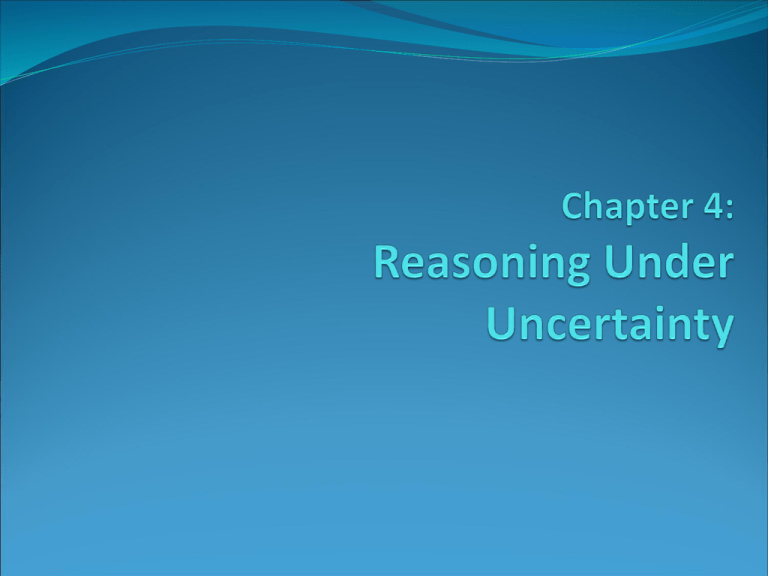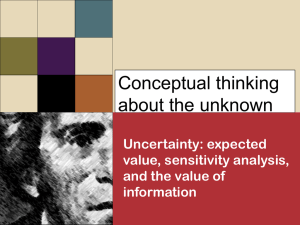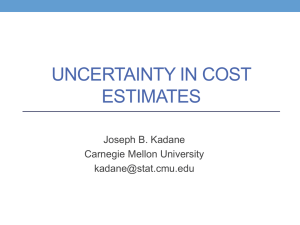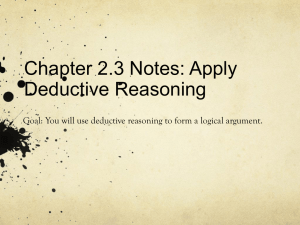Chapter 1: Introduction to Expert Systems
advertisement

Objectives Learn the meaning of uncertainty and explore some theories designed to deal with it Find out what types of errors can be attributed to uncertainty and induction Learn about classical probability, experimental, and subjective probability, and conditional probability Explore hypothetical reasoning and backward induction 4/13/2015 2 Objectives Examine temporal reasoning and Markov chains Define odds of belief, sufficiency, and necessity Determine the role of uncertainty in inference chains Explore the implications of combining evidence Look at the role of inference nets in expert systems and see how probabilities are propagated 4/13/2015 3 How to Expert Systems Deal with Uncertainty? Expert systems provide an advantage when dealing with uncertainty as compared to decision trees. With decision trees, all the facts must be known to arrive at an outcome. Probability theory is devoted to dealing with theories of uncertainty. There are many theories of probability – each with advantages and disadvantages. 4/13/2015 4 What is Uncertainty? Uncertainty is essentially lack of information to formulate a decision. Uncertainty may result in making poor or bad decisions. As living creatures, we are accustomed to dealing with uncertainty – that’s how we survive. Dealing with uncertainty requires reasoning under uncertainty along with possessing a lot of common sense. 4/13/2015 5 Dealing with Uncertainty Deductive reasoning – deals with exact facts and exact conclusions Inductive reasoning – not as strong as deductive – premises support the conclusion but do not guarantee it. There are a number of methods to pick the best solution in light of uncertainty. When dealing with uncertainty, we may have to settle for just a good solution. 4/13/2015 6 Theories to Deal with Uncertainty 4/13/2015 Bayesian Probability Hartley Theory Shannon Theory Dempster-Shafer Theory Markov Models Zadeh’s Fuzzy Theory 7 Errors Related to Hypothesis Many types of errors contribute to uncertainty. Type I Error – accepting a hypothesis when it is not true – False Positive. Type II Error – Rejecting a hypothesis when it is true – False Negative 4/13/2015 8 Errors Related to Measurement Errors of precision – how well the truth is known Errors of accuracy – whether something is true or not Unreliability stems from faulty measurement of data – results in erratic data. Random fluctuations – termed random error Systematic errors result from bias 4/13/2015 9 Errors in Induction Where deduction proceeds from general to specific, induction proceeds from specific to general. Inductive arguments can never be proven correct (except in mathematical induction). Expert systems may consist of both deductive and inductive rules based on heuristic information. When rules are based on heuristics, there will be uncertainty. 4/13/2015 10 Deductive and Inductive Reasoning about Populations and Samples 4/13/2015 11 Types of Errors 4/13/2015 12 Examples of Common Types of Errors 4/13/2015 13 Classical Probability First proposed by Pascal and Fermat in 1654 Also called a priori probability because it deals with ideal games or systems: Assumes all possible events are known Each event is equally likely to happen Fundamental theorem for classical probability is P = W / N, where W is the number of wins and N is the number of equally possible events. 4/13/2015 14 Deterministic vs. Nondeterministic Systems When repeated trials give the exact same results, the system is deterministic. Otherwise, the system is nondeterministic. Nondeterministic does not necessarily mean random – could just be more than one way to meet one of the goals given the same input. 4/13/2015 15 Three Axioms of Formal Theory of Probability If E1 and E2 are mutually exclusive events 4/13/2015 16 Experimental and Subjective Probabilities Experimental probability defines the probability of an event, as the limit of a frequency distribution: Experimental probability is also called a posteriori (after the event) Subjective probability deals with events that are not reproducible and have no historical basis on which to extrapolate. 17 Compound Probabilities Compound probabilities can be expressed by: S is the sample space and A and B are events. Independent events are events that do not affect each other. For pairwise independent events, 18 Additive Law 4/13/2015 19 Conditional Probabilities The probability of an event A occurring, given that event B has already occurred is called conditional probability: 20 Sample Space of Intersecting Events 4/13/2015 21 Advantages and Disadvantages of Probabilities Advantages: formal foundation reflection of reality (posteriori) Disadvantages: may be inappropriate the future is not always similar to the past inexact or incorrect especially for subjective probabilities Ignorance probabilities must be assigned even if no information is available assigns an equal amount of probability to all such items non-local reasoning requires the consideration of all available evidence, not only from the rules currently under consideration no compositionality complex statements with conditional dependencies can not be decomposed into independent parts 22 4/13/2015 Bayes’ Theorem This is the inverse of conditional probability. Find the probability of an earlier event given that a later one occurred. 23 Hypothetical Reasoning Backward Induction Bayes’ Theorem is commonly used for decision tree analysis of business and social sciences. especially useful in diagnostic systems medicine, computer help systems inverse or a posteriori probability inverse to conditional probability of an earlier event given that a later one occurred PROSPECTOR (expert system) achieved great fame as the first expert system to discover a valuable molybdenum deposit worth $100,000,000. 4/13/2015 24 Bayes’ Rule for Multiple Events Multiple hypotheses Hi, multiple events E1, …, En P(Hi|E1, E2, …, En) = (P(E1, E2, …, En|Hi) * P(Hi)) / P(E1, E2, …, En) or P(Hi|E1, E2, …, En)= (P(E1|Hi) * P(E2|Hi) * …* P(En|Hi) * P(Hi)) / Σk P(E1|Hk) * P(E2|Hk) * … * P(En|Hk)*P(Hk) with independent pieces of evidence Ei 25 Advantages and Disadvantages of Bayesian Reasoning Advantages: sound theoretical foundation well-defined semantics for decision making Disadvantages: requires large amounts of probability data subjective evidence may not be reliable independence of evidences assumption often not valid relationship between hypothesis and evidence is reduced to a number explanations for the user difficult high computational overhead Major problem: the relationship between belief and disbelief P (H | E) = 1 - P (H' | E) may not always work! 26 Temporal Reasoning Reasoning about events that depend on time Expert systems designed to do temporal reasoning to explore multiple hypotheses in real time are difficult to build. One approach to temporal reasoning is with probabilities – a system moving from one state to another over time. The process is stochastic if it is probabilistic. 4/13/2015 27 Markov Chain Process Transition matrix – represents the probabilities that the system in one state will move to another. State matrix – depicts the probabilities that the system is in any certain state. One can show whether the states converge on a matrix called the steady-state matrix – a time of equilibrium 4/13/2015 28 Markov Chain Characteristics 1. 2. 3. 4. 4/13/2015 The process has a finite number of possible states. The process can be in one and only one state at any one time. The process moves or steps successively from one state to another over time. The probability of a move depends only on the immediately preceding state. 29 State Diagram Interpretation of a Transition Matrix 4/13/2015 30 The Odds of Belief To make expert systems work for use, we must expand the scope of events to deal with propositions. Rather than interpreting conditional probabilities P(A|B) in the classical sense, we interpret it to mean the degree of belief that A is true, given B. We talk about the likelihood of A, based on some evidence B. This can be interpreted in terms of odds. 4/13/2015 31 The Odds of Belief (cont.) The conditional probability could be referred to as the likelihood. Likelihood could be interpreted in terms of odds of a bet. The odds of A against B given some event C is: P( A | C ) P( A | C ) If B A': odds P( B | C ) 1 P( A | C ) defining P P( A | C ) then : odds odds 4/13/2015 P wins odds ( ) and P 1 P losses 1 odds 32 The Odds of Belief (cont.) The likelihood of P=95% (for the car to start in the morning) is thus equivalent to: odds P 0.95 19 to 1 1 P 1 0.95 Probability is natural forward chaining or deductive while likelihood is backward chaining and inductive. Although we use the same simbol, P(A|B), for probability and likelihood the applications are different. 4/13/2015 33 Sufficiency and Necessity The likelihood of sufficiency, LS, is calculated as: The likelihood of necessity is defined as: 34 Relationship Among Likelihood Ratio, Hypothesis, and Evidence 4/13/2015 35 Relationship Among Likelihood of Necessity, Hypothesis, and Evidence 4/13/2015 36 Uncertainty in Inference Chains Uncertainty may be present in rules, evidence used by rules, or both. One way of correcting uncertainty is to assume that P(H|e) is a piecewise linear function. 4/13/2015 37 Intersection of H and e 4/13/2015 38 Piecewise Linear Interpolation Function for Partial Evidence in PROSPECTOR 4/13/2015 39 Combination of Evidence The simplest type of rule is of the form: IF E THEN H where E is a single piece of known evidence from which we can conclude that H is true. Not all rules may be this simple – compensation for uncertainty may be necessary. As the number of pieces of evidence increases, it becomes impossible to determine all the joint and prior probabilities or likelihoods. 4/13/2015 40 Combination of Evidence Continued If the antecedent is a logical combination of evidence, then fuzzy logic and negation rules can be used to combine evidence. 4/13/2015 41 Types of Belief Possible – no matter how remote, the hypothesis cannot be ruled out. Probable – there is some evidence favoring the hypothesis but not enough to prove it. Certain – evidence is logically true or false. Impossible – it is false. Plausible – more than a possibility exists. 4/13/2015 42 Figure 4.20 Relative Meaning of Some Terms Used to Describe Evidence 4/13/2015 43 Propagation of Probabilities The chapter examines the classic expert system PROSPECTOR to illustrate how concepts of probability are used in a real system. Inference nets like PROSPECTOR have a static knowledge structure. Common rule-based system is a dynamic knowledge structure. 4/13/2015 44 Summary In this chapter, we began by discussing reasoning under uncertainty and the types of errors caused by uncertainty. Classical, experimental, and subjective probabilities were discussed. Methods of combining probabilities and Bayes’ theorem were examined. PROSPECTOR was examined in detail to see how probability concepts were used in a real system. 4/13/2015 45 Summary An expert system must be designed to fit the real world, not visa versa. Theories of uncertainty are based on axioms; often we don’t know the correct axioms – hence we must introduce extra factors, fuzzy logic, etc. We looked at different degrees of belief which are important when interviewing an expert. 4/13/2015 46








